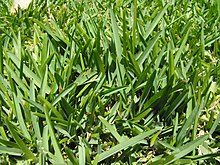St. Augustine Grass
| St. Augustine Grass | |
|---|---|
 |
|
| Scientific classification | |
| Kingdom: | Plantae |
| (unranked): | Angiosperms |
| (unranked): | Monocots |
| (unranked): | Commelinids |
| Order: | Poales |
| Family: | Poaceae |
| Subfamily: | Panicoideae |
| Tribe: | Paniceae |
| Genus: | Stenotaphrum |
| Species: | S. secundatum |
| Binomial name | |
|
Stenotaphrum secundatum (Walt.) Kuntze |
|
St. Augustine grass (Stenotaphrum secundatum) (also known as Charleston grass in South Carolina and buffalo turf in Australia) is a warm-season lawn grass that is popular for cultivation in tropical and subtropical regions. It is a medium- to high-maintenance grass that forms a thick, carpetlike sod, crowding out most weeds and other grasses.
St. Augustine is a dark green grass with broad, flat blades. It spreads by aboveground stolons, commonly known as "runners", and forms a dense layer.
The grass occurs on both sides of the Atlantic Ocean, including much of the southeastern United States, Texas, Mexico, and Central and South America. It has escaped cultivation in California, Hawaii, many Pacific islands, and New Zealand.
St. Augustine grass occurs in most Caribbean and Mediterranean areas. It grows best in tropical climates. It is often seen in lagoons and marshes, on shorelines, and wherever there is a good amount of moisture.
Only recently has commercially valuable and viable seed for St. Augustine become available, so it has typically been propagated by plugs, sprigs, or sod. Once the grass is cultivated, it can propagate on its own.
St. Augustine can grow in a wide range of soil types with a pH between 5.0 and 8.5. It usually blooms in spring and summer.
St. Augustine grass is commonly used in pastures and on ranches. It is a popular lawn grass, rivalling bermudagrass, though St. Augustine is somewhat less drought-tolerant.
A number of cultivars have been developed:
...
Wikipedia
